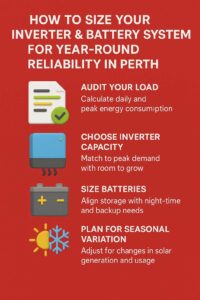Ensuring uninterrupted power supply in Perth requires careful planning when sizing your inverter and battery system. Perth’s climate, with long sunny summers and cooler, shorter winter days, means solar energy generation and consumption patterns change throughout the year. Choosing the right balance of inverter capacity and battery storage is key to ensuring efficiency, reliability, and cost-effectiveness.
Understanding Your Energy Load
The first step in system design is to calculate your energy consumption. This involves:
- Reviewing electricity bills to identify daily, monthly & seasonal usage.
- Categorising loads into essential (fridges, lighting, communications) and non-essential (pool pumps, entertainment systems).
- Considering peak demand, which is the maximum energy drawn at one time, to ensure your inverter can handle it.
By identifying your base load (minimum daily usage) and seasonal spikes, you establish the foundation for system capacity requirements.
Sizing the Inverter
The inverter is responsible for converting DC power from solar panels and batteries into usable AC power for your home or business. Correct sizing is critical:
- Match demand: The inverter should meet or exceed the peak load to avoid shutdowns.
- Allow headroom: Oversizing slightly ensures capacity for future appliances or increased consumption.
- Efficiency balance: An oversized inverter may operate inefficiently at low loads, while an undersized inverter risks overload.
Professional suppliers of solar inverters Perth can advise on models tailored to both residential and commercial applications.
Calculating Battery Storage Needs
Battery capacity determines how long your system can run without input from solar panels or the grid. Key considerations include:
- Depth of discharge (DoD): Only a percentage of the battery’s capacity is usable.
- Autonomy: How many hours or days you want backup power for, especially during cloudy winter weeks.
- Recharge rate: Batteries must recharge quickly enough during daylight hours to cover night-time usage.
Lithium batteries, with higher DoD and longer lifespans, are increasingly the standard for reliable storage.
Seasonal Demand Changes in Perth
Perth households typically consume more energy in summer due to air conditioning, while winter days produce less solar energy. To design for year-round reliability:
- Factor in lower solar generation in June–August when daylight is shortest.
- Size storage to cover night heating loads in winter.
- Consider smart load management, such as scheduling pool pumps or EV charging during peak solar hours.
This seasonal balancing ensures you don’t overinvest in equipment while still maintaining consistent reliability.

Steps to Right-Sizing Your System
- Audit your load: Establish daily, peak & seasonal consumption patterns.
- Choose inverter capacity: Match to peak demand with margin for growth.
- Size batteries: Align with night-time loads & backup requirements.
- Plan for seasonal variation: Adjust design for Perth’s summer/winter differences.
- Engage experts: Local installers provide insights into regional conditions and regulatory requirements.
Conclusion
A well-sized inverter and battery system provides stable, cost-efficient energy across Perth’s changing seasons. By calculating energy loads accurately, matching inverter capacity to demand, and ensuring adequate battery storage, homeowners and businesses can achieve long-term reliability. Professional consultation with solar battery Perth specialists ensures your system is tailored for performance, resilience, and future energy needs.

